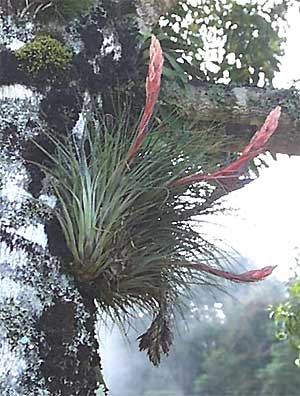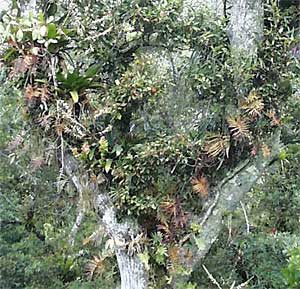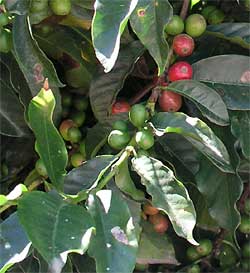|
NATURE STUDY WORKSHOPS
in the cloudforest of
Chiapas, Mexico

Chiapas is
Mexico's southernmost state, wedged between Guatemala to the east, the Pacific Ocean to
the South, the Yucatan Peninsula to the north, and the Isthmus of Tehuantepec to the west.
It is also the Mexican state with the highest species
and cultural diversity.
 In much of backcountry Chiapas it is not safe
to wander in isolated areas. However, Jim has friends in the uplands where mountain peaks
meet the clouds to form cloudforest. Here the humidity is high, the air cool, the local
mostly-Zoque-Indian people are very friendly, and conditions could not be more favorable
for taking hikes and studying nature. The picture at the right shows a large, epiphytic
bromeliad on a tree. In much of backcountry Chiapas it is not safe
to wander in isolated areas. However, Jim has friends in the uplands where mountain peaks
meet the clouds to form cloudforest. Here the humidity is high, the air cool, the local
mostly-Zoque-Indian people are very friendly, and conditions could not be more favorable
for taking hikes and studying nature. The picture at the right shows a large, epiphytic
bromeliad on a tree.
During the northern winter, by focusing on the plants and animals
around us in a very pleasant, interesting environment, we can learn the basics of nature
study.
- By studying the flowers of roadside
weeds as well as orchids and other fabulous plants from the cloudforest, we can learn
flower anatomy so that when you return to your home you can begin identifying the plants
in your own area.
- Listing the local birds, we can
learn birdwatching techniques which will apply to your home-area birds. View the list of
bird species spotted during our 2005 workshop here.
- Studying the local ecology, we can
learn basic principles of ecology that will help you understand your own region when you
return home.
 Lodging is primitive and
getting to the location takes a bit of time. However, here you can see plants and animals
never found in the lowlands -- such as the aroids, ferns, bromeliads, and orchids on the
tree at the left. Lodging is primitive and
getting to the location takes a bit of time. However, here you can see plants and animals
never found in the lowlands -- such as the aroids, ferns, bromeliads, and orchids on the
tree at the left.
Chiapas workshops are only for those really interested in wild
nature and willing to put up with a few inconveniences.
The workshops take place just outside the small town of Pantepec,
just west of Rayón, on the twisty road between Teapa and Tuxtla Gutiérrez in western
Chiapas. Spanish is spoken by nearly everyone except for some of the older inhabitants,
but most of the people are of the Zoque, Tzotzil and Chol indiginous groups. Many people
know a great deal about medicinal uses of local plants, local wildlife, and other matters
of traditional concern.
 The main industry of the area is forestry.
This means that most of the forest has been destroyed -- converted to cornfields, weeds or
cow pastures. Many people also grow coffee. At the right you see coffee beans on a tree in
a garden beside a hut in Pantepec. The main industry of the area is forestry.
This means that most of the forest has been destroyed -- converted to cornfields, weeds or
cow pastures. Many people also grow coffee. At the right you see coffee beans on a tree in
a garden beside a hut in Pantepec.
Arrangements for these workshops will be made on a customized basis
for small groups. Basically, the more comfort and care you need, the more it'll cost. Jim
has no fixed fee for his teaching services and prefers to barter. Just drop Jim a note. Something can be worked out for anyone with
a sincere desire to know more about nature and the people, plants and animals of Mexico.
Return to Hacienda San Juan Page |
Review these items at Amazon.com:
A DVD:
A Map:
Books:
|
|

 In much of backcountry Chiapas it is not safe
to wander in isolated areas. However, Jim has friends in the uplands where mountain peaks
meet the clouds to form cloudforest. Here the humidity is high, the air cool, the local
mostly-Zoque-Indian people are very friendly, and conditions could not be more favorable
for taking hikes and studying nature. The picture at the right shows a large, epiphytic
bromeliad on a tree.
In much of backcountry Chiapas it is not safe
to wander in isolated areas. However, Jim has friends in the uplands where mountain peaks
meet the clouds to form cloudforest. Here the humidity is high, the air cool, the local
mostly-Zoque-Indian people are very friendly, and conditions could not be more favorable
for taking hikes and studying nature. The picture at the right shows a large, epiphytic
bromeliad on a tree. Lodging is primitive and
getting to the location takes a bit of time. However, here you can see plants and animals
never found in the lowlands -- such as the aroids, ferns, bromeliads, and orchids on the
tree at the left.
Lodging is primitive and
getting to the location takes a bit of time. However, here you can see plants and animals
never found in the lowlands -- such as the aroids, ferns, bromeliads, and orchids on the
tree at the left. The main industry of the area is forestry.
This means that most of the forest has been destroyed -- converted to cornfields, weeds or
cow pastures. Many people also grow coffee. At the right you see coffee beans on a tree in
a garden beside a hut in Pantepec.
The main industry of the area is forestry.
This means that most of the forest has been destroyed -- converted to cornfields, weeds or
cow pastures. Many people also grow coffee. At the right you see coffee beans on a tree in
a garden beside a hut in Pantepec.